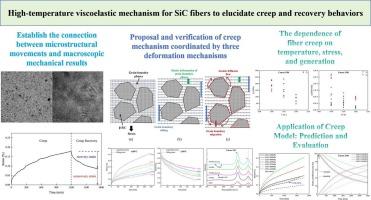碳化硅纤维的高温粘弹性机理,以阐明其蠕变和恢复行为
IF 7.9
2区 材料科学
Q1 MATERIALS SCIENCE, MULTIDISCIPLINARY
引用次数: 0
摘要
研究碳化硅纤维的高温蠕变特性对增强陶瓷基复合材料的设计具有重要意义。由于晶粒内部和晶界之间复杂的相互协调作用,蠕变粘弹性行为在高温下被激活。研究了不同应力和温度条件下不同世代SiC纤维的拉伸蠕变行为。卸载后的蠕变恢复行为表现为粘弹性,这是由于非晶相可能在块状晶界附近运动所致。它是由晶界弹性能量的释放驱动的,拉曼光谱的频移证明了这一点。然后将经典的扩散蠕变理论修正为包含SiC纤维弹性、粘度和阈值应力等物理参数的粘弹性模型。蠕变试验结果很好地支持了所提出的方程。黏度和弹性参数随温度的升高而降低,其中弹性参数对温度更为敏感。第三代纤维具有更高的粘度和弹性,解释了更好的抗蠕变性能。该模型可以评估弹性和塑性贡献,并预测高温下的蠕变结果。本研究有助于理解高温碳化硅纤维蠕变,并指导纤维增强复合材料的优化。本文章由计算机程序翻译,如有差异,请以英文原文为准。

High-temperature viscoelastic mechanism for SiC fibers to elucidate creep and recovery behaviors
Mastering the high-temperature creep behavior of SiC fibers plays pivotal role in designing reinforced ceramic matrix composites. Creep viscoelastic behavior is activated at higher temperatures due to complicated interactive coordination between grain interiors and grain boundaries. This study investigated the tensile creep behaviors at different generations of SiC fibers under conditions of various stress and temperatures. The creep recovery behaviors after unloading exhibits the viscoelastic nature, which comes from the possible motion of amorphous phase near massive grain boundaries. It is driven by the release of elastic energy of the grain boundary, evidenced by frequency shifts in Raman spectroscopy. Then classical diffusion creep theory is modified to a viscoelastic model incorporating physical parameters such as the elasticity, viscosity, and threshold stress for SiC fibers. The proposed equations have been well supported by creep test results. The viscosity and elasticity parameters decrease with increasing temperature, the latter being more sensitive. 3rd generation fiber exhibits higher viscosity and elasticity, explaining better creep resistance. The model can evaluate the elastic and plastic contributions and predict creep results at higher temperatures. This work helps to understand high-temperature SiC fiber creep, and to guide optimizing fiber-reinforced composites.
求助全文
通过发布文献求助,成功后即可免费获取论文全文。
去求助
来源期刊

Materials & Design
Engineering-Mechanical Engineering
CiteScore
14.30
自引率
7.10%
发文量
1028
审稿时长
85 days
期刊介绍:
Materials and Design is a multi-disciplinary journal that publishes original research reports, review articles, and express communications. The journal focuses on studying the structure and properties of inorganic and organic materials, advancements in synthesis, processing, characterization, and testing, the design of materials and engineering systems, and their applications in technology. It aims to bring together various aspects of materials science, engineering, physics, and chemistry.
The journal explores themes ranging from materials to design and aims to reveal the connections between natural and artificial materials, as well as experiment and modeling. Manuscripts submitted to Materials and Design should contain elements of discovery and surprise, as they often contribute new insights into the architecture and function of matter.
 求助内容:
求助内容: 应助结果提醒方式:
应助结果提醒方式:


